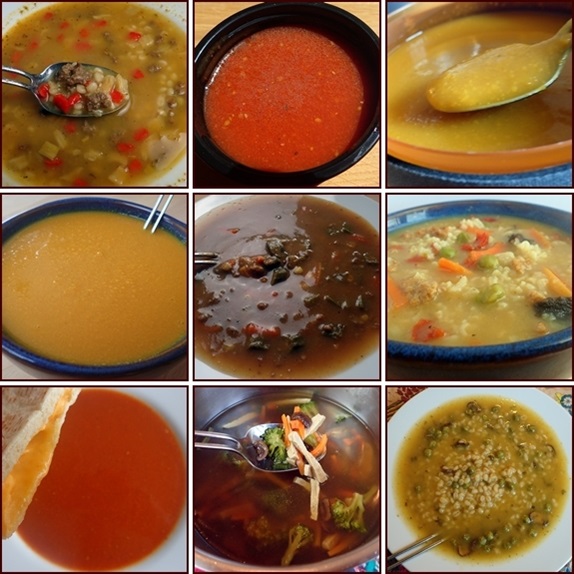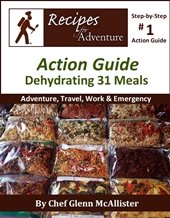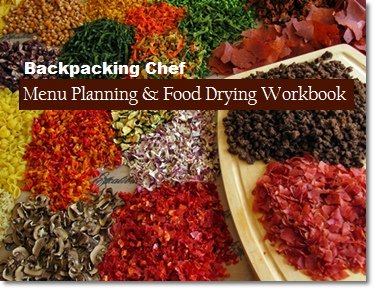Dehydrated Soup Recipes
It’s easy to create delicious dehydrated soup recipes if you’re already dehydrating meals and keeping a variety of dried vegetables, meats, and starches on hand. This page discusses several approaches to making and dehydrating soup.
One method of making dehydrated soups is to cook a thick soup and run the whole batch through a blender, or whip it smooth with an immersion blender. Spread the blended soup thinly on dehydrator trays, dehydrate it into a brittle bark, then grind the soup bark into soup powder. This type of dried soup mix rehydrates quickly with boiled water. See the Potato-Leek Dehydrated Soup Recipe on this page.
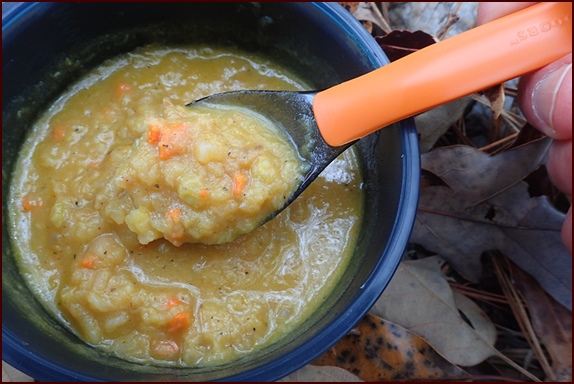
Photo: Fish Chowder rehydrated on the trail.
A similar way of dehydrating soup is to blend a portion of the cooked ingredients until smooth, and then recombine the solids with the blended portion. See the Fish Chowder Recipe.
Another way to come up with an unlimited variety of dehydrated soup recipes is to combine a few of the dried foods from your storage. It’s a good idea to use up dried food within a year. You can store dried meats and vegetables longer if they are sealed in airtight containers, but rotating your home-dried food supply every year ensures the best taste and vitality of the food.
Two-thirds of a cup of dried ingredients—any combination of dried meat, vegetables, beans, or starches—along with extra seasonings, will make a good dehydrated soup for one person when reconstituted with two cups of water.
To make the broth of dehydrated soups more flavorful, add a little vegetable, chicken, or beef bouillon. Sometimes just a pinch of salt and pepper will do. Another way of flavoring dry soup mixes is to include tomato powder or vegetable soup powder. See the Ratatouille & Rice Dehydrated Soup Recipe on this page.
You can also turn dehydrated meals into dehydrated soups after the backpacking season is over. All you have to do is use more water, plus bump the seasonings up. See the Crab Marinara Dehydrated Soup Recipe on this page.
Make hybrid dehydrated soups at home by using both fresh and dehydrated ingredients. The Chicken & Vegetable soup shown below was made with fresh ingredients. Dehydrated rice or dried pasta could easily be added to it shortly before serving.
One last way of dehydrating soup…
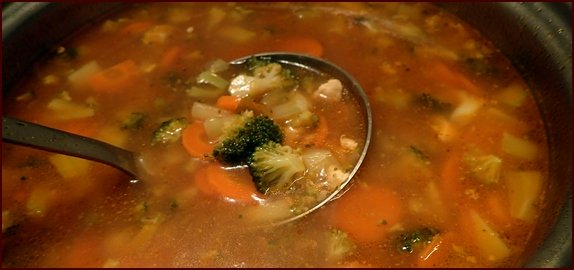
If you wanted to dehydrate a soup like the Chicken & Vegetable Soup shown above, separate the cooked solids from the broth. Add some of the cooked solids back to the broth and blend with an immersion blender until you have a thick mixture. Spread the mixture thinly on dehydrator trays and dry it into soup bark. Dry the remaining soup solids on a separate tray, making sure that the pieces are cut about the same size and not too large. Once dry, the soup bark can be ground into soup powder. Combine the soup powder with the dried solids and divide into individual servings.
Here is a list of dehydrated soup recipes on the Backpacking Chef website. Each recipe has instructions for dehydrating soup using the different methods discussed above.
Guide to Dehydrated Soup Recipes
Dehydrated Soup Recipes on this page...
Potato-Leek Soup
Ratatouille & Rice Soup
Crab Marinara Soup
Vegetable-Bean Soup with Garlic & Tomato
Dehydrated Soup Recipes on the website...
Tofu-Vegetable Soup
Butternut Squash Soup
Sweet Potato & Carrot Soup
Curry-Carrot Soup
Zucchini-Potato Soup

Dehydrated Soup Recipes in Trail Bytes...
Potato-Broccoli Soup
Tomato-Carrot Soup
Fish Chowder
Pumpkin Soup
Gazpacho
Barley with Peas & Mushroom Soup
Beef & Barley Soup
Subscribe to Trail Bytes
Dehydrated Soup Recipes shared by Readers...
Instant Black Bean Soup
Stuffed Pepper Soup
Quick Backpack Chili
Thai Pumpkin-Carrot Soup
Chicken & Potato Bark Soup
Potato-Leek Soup
This is an example of dehydrating soup by cooking and blending the whole batch, which you dry into soup bark.
Servings: 6–7 (13 cups)
Ingredients:
- 3¾ lb. potatoes, peeled and chunked (1.7 kg)
- ½ lb. leeks (6 layers of a leek, cut into small pieces) (227 g)
- 11 cups chicken or veg. broth, or water with bouillon (2.6 L)
- 4 cloves garlic, minced
- 1 tsp. salt
- ¼ tsp. pepper
- 1 tsp. thyme, fresh preferred
- 3 bay leaves
- 2 tsp. cooking oil
- ½ cup half-and-half (added for immediate serving, not for dehydration)
Cooking Potato-Leek Soup
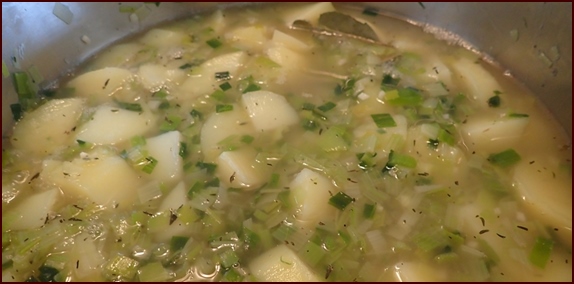
Photo shows soup cooking before it was blended.
Peel and chunk potatoes, and add to a large soup pot with salt and pepper, bay leaves, and thyme. Add enough chicken or vegetable broth to cover potatoes by half an inch. Bring to a boil, and then reduce heat to a simmer. Retain the rest of the broth.
Cut 6 to 8 layers from a leek and wash thoroughly. Remove tips if dried out, but otherwise use both the dark green and lighter parts of the leek. Slice lengthwise into thinner strips and then across into small pieces.
Add leeks and minced garlic to a frying pan coated with 2 teaspoons of cooking oil, and cook over medium heat. While the leeks are cooking, add broth to the pan ¼ cup at a time to keep the leeks from burning. By adding broth, no additional oil is needed.
When the leeks are soft after about 10 minutes, add to the soup pot with the potatoes, and simmer for an additional 10 minutes. Remove from heat, and let it cool.
Remove bay leaves, and run the soup through a blender until smooth. This may take 2 to 3 loads; an extra pot will be helpful to hold the soup as it comes out of the blender.
If serving immediately, thin soup with half-and-half and broth to desired consistency, and reheat soup.
Dehydrating Potato-Leek Soup
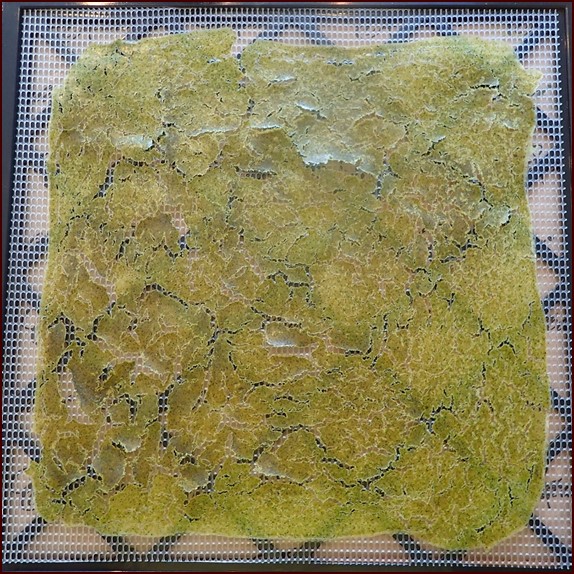
Spread thinly on dehydrator trays covered with nonstick sheets or fruit-roll inserts.
Dehydrate at 135°F (57°C) for 6–8 hours or until brittle.
To speed up drying and to thoroughly dry the underside of the soup bark, flip the bark over when it is almost dry, and peel away the nonstick sheets. Finish drying directly on mesh sheets.
Break soup bark into smaller pieces when dry. For faster rehydration, grind bark into powder.
Yield: 13 cups of soup will yield 7–8 cups of bark. One cup of bark weighs approximately 48 grams. One cup of bark can be reduced to ¼ cup (4 Tbsp.) powdered soup, also 48 grams.
Rehydrating Potato-Leek Soup
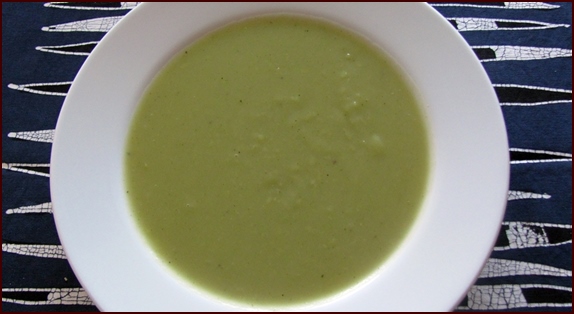
Photo: Rehydrated Potato-Leek Soup.
Add 2 Tbsp. (24 g) of soup powder per cup (237 ml) of water.
Regular Serving: 3 Tbsp. soup powder (36 g), 1½ cups water (355 ml).
Large Serving: 4 Tbsp. soup powder (48 g), 2 cups water (473 ml).
Pot Cooking: Add ingredients to pot with water, and soak 5 minutes. Bring to boil for 1 minute, then transfer pot to an insulating cozy for 15 minutes.
Thermos Cooking: Add boiled water to ingredients in thermos. Wait 20 minutes, up to several hours. Use a ½ cup extra boiled water for longer soak times; soup thickens.
Ratatouille & Rice Soup
This is an example of a dehydrated soup made from separately dried ingredients, plus tomato powder as a flavor booster.
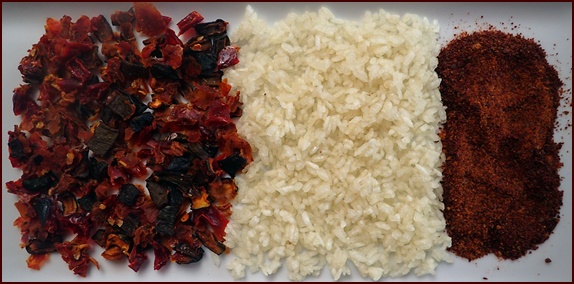
Servings: 1
Ingredients:
- ⅓ cup dried ratatouille (20 g)
- ⅓ cup dried rice (40 g)
- 1 Tbsp. tomato powder (12 g)
- 2 cups water to rehydrate
Pot Cooking: Add ingredients to pot with water, and soak 5 minutes. Bring to boil for 1 minute, then transfer pot to an insulating cozy for 15 minutes. Soup thickens more if you can wait longer.
Thermos Cooking: Add boiled water to ingredients in thermos. Wait 20 minutes, up to several hours. Use a ½ cup extra boiled water for longer soak times; soup thickens.
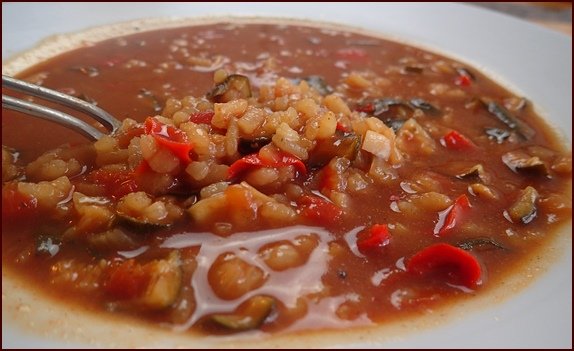
Photo: Rehydrated Ratatouille & Rice Soup
Crab Marinara Soup
This is an example of a dehydrated soup made from a previously dehydrated meal. This meal is featured in The Action Guide: Dehydrating 31 Meals.
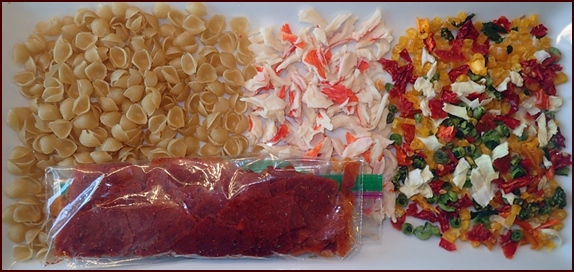
Servings: 2–3
Meal Ingredients: ¾ cup precooked-and-dried pasta (70 g), ⅓ cup dried mixed vegetables (20 g), ⅓ cup dried imitation crabmeat (25 g), and ⅓ cup marinara-sauce leather (25 g).
Additional Ingredients: ¼ tsp. salt, ⅛ tsp. pepper, ⅛ tsp. Old Bay Seasoning, Pinch each: herbs de Provence, oregano, basil, and red pepper flakes
To make it a soup, triple the rehydration water specified in the recipe. That translates to 5¼ cups of water (242 ml) instead of the usual 1¾ cups (414 ml). Naturally, the meal-turned-soup needs a few pinches of seasonings to make it tasty. With the additional seasonings, the tomato stock tastes like minestrone.
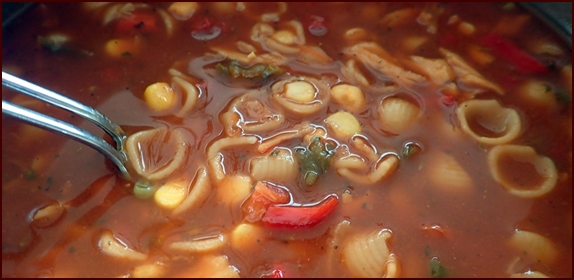
Photo: Rehydrated Crab Marinara Soup
Soup Preparation: Soak the dried ingredients in the water for 5 minutes, then bring to a boil. Reduce to a light simmer for a few more minutes, then take the pot off the heat. For best results, let the soup sit covered for 30 minutes or more off the heat. Adjust seasonings and reheat prior to serving.
Vegetable-Bean Soup with Garlic & Tomato
This is an example of a hybrid dehydrated soup recipe to serve the whole family at home using both fresh and dried ingredients.
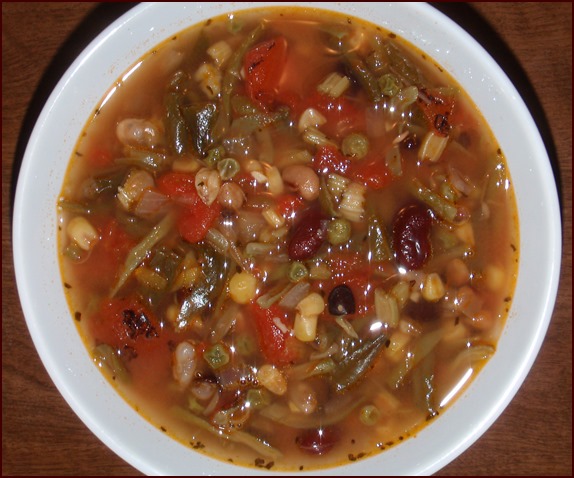
Servings: 4–6
Ingredients:
- 2 cups dried mixed vegetables, any kind (green beans, carrots, corn, peas, bell peppers, celery, etc.)
- 1 cup dried beans (red, black, and/or white)
- 1 14.5 ounce can seasoned diced tomatoes, such as fire-roasted
- 1 Tbsp. olive oil
- 2 slices large red onion, diced
- 1 clove garlic, minced
- 1 packet Swanson Flavor Boost (vegetable)
- ½ tsp. salt
- ¼ tsp. pepper
- ¼ tsp. dried basil
- 9 cups Water
Instructions:
In a soup pot, soak dried vegetables and beans in nine cups of water with seasonings for five minutes. Turn on stove and bring to boil for a minute and then turn down heat to simmer.
In a separate pan, cook onions and garlic in olive oil on med-low for five minutes. Add diced tomatoes, bring to boil, and then reduce heat to simmer for ten minutes.
Add contents of pan to soup pot and simmer ten minutes or longer.
Vegetable Soup Powder

One of the most useful dehydrated soup recipes included in Recipes for Adventure II: The Best of Trail Bytes is vegetable soup powder. Starting with a concentrated base of healthy vegetables, the soup is blended, dried, and powdered. It’s super healthy and more natural than the typical bouillon cube.

With vegetable soup powders, you can make an unlimited variety of dehydrated soups, from thick and creamy soups, to flavorful broths supporting extra meats, vegetables, beans, and starches.
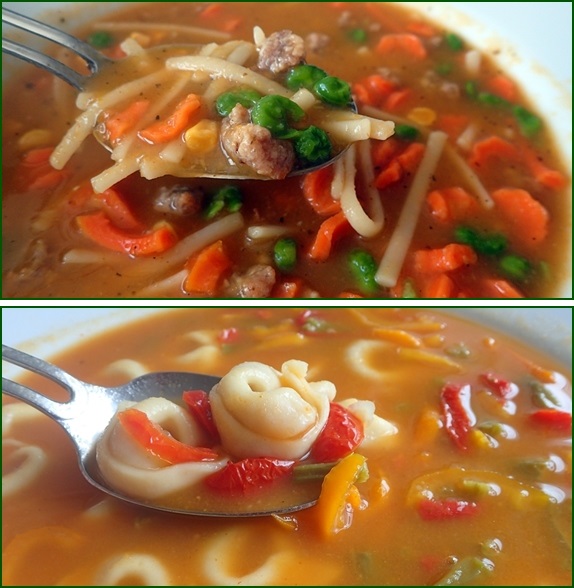
Photos: (Top) Chicken Noodle Soup made with vegetable soup powder. (Bottom) Tortellini Soup made with a combination of vegetable soup powder and tomato-carrot soup powder.
Dehydrated Soup Recipes Shared by Backpacking Chef Readers
If you would like to share a dehydrated soup recipe, please send it using this recipe submission form.
Instant Black Bean Soup
Shared by Skip Jackson
Ingredients:
- 2 cans of black beans
- 1 can of diced tomatoes and green chili
- 1 tsp. ground red chili powder
- 2 tsp. cumin
- 1 tsp. white pepper
- 1 tsp. garlic powder
- 1 tsp. onion powder
- 2 Tbsp. of lime juice
- Kosher salt to taste
- 1 tsp. cilantro flakes
- 1 tsp. dried red peppers (optional)
At Home:
Use a blender to mix all ingredients till they are smooth. Dehydrate until very dry. Powder in a blender. Package in baggie or other container when taking it on the trail. I store it in a pint mason jar in the pantry until needed.
On the Trail:
Add three heaping tablespoons soup powder to a cup of boiling water and stir well. Garnish with fresh cilantro and sour cream if desired. Dip a flour tortilla in the hot soup, enjoy.
Stuffed Pepper Soup
Shared by Justin Korpal
Ingredients:
- ¼ cup instant rice
- ¼ cup dried green bell peppers
- ¼ cup dried red bell peppers
- ¼ cup dried orange bell peppers
- ¼ cup dried ground beef
- ¼ cup dried tomato sauce leather
- Oregano, pinch
- Thyme, pinch
- Italian seasoning, pinch
- Tabasco pepper sauce, dash
- 3 cups water to rehydrate
At Home:
Pack all dry soup mix ingredients in a plastic bag. Consider packing tomato sauce leather in a separate plastic bag if it feels tacky.
On the Trail:
Rehydrate with about three cups of water. Add seasonings, and pepper sauce to taste.
Quick Backpack Chili
Shared by Paul Radosevich
Ingredients:
- ½ cup parboiled, 'Minute Rice', or cooked and dehydrated rice.
- ¼ cup dried ground beef
- ¼ cup dried beans (red, kidney, pinto, black or combination)
- ¼ cup dried tomatoes
- ¼ cup dried onions
- 4x4 square of dried tomato paste (fruit leather made with paste)
- 4 Tbsp. Chili Seasoning (envelope from store or own mix)
- 3 to 3½ cups water to rehydrate
Optional- dehydrated diced hot peppers to taste
At Home:
Put all ingredients into container. I prefer vacuum seal bags for longer storage, but a freezer bag or canning jar works.
On the Trail:
Add 2¼ times the volume of water to dry ingredients. You can add boiling water to ingredients in a freezer bag, or heat water and ingredients together in pot using any means- a MRE heater, pocket stove, gas burner, or even an open wood flame.
Thai Pumpkin-Carrot Soup
Shared by Leslie Russell
Ingredients:
- 1 large shallot, peeled, roasted
- 4 big carrots, sliced
- 1 cup pumpkin or butternut squash, cubed
- 1 cup chicken stock
- 1 can lite coconut milk
- 1 big bunch cilantro, stemmed
- 1 squirt of Sriracha (Thai hot sauce)
- 1 Tbsp. fish sauce
- 1 lime, juiced
- Salt to taste
At Home:
Bring all but the cilantro and lime to a good simmer. When the vegetables are soft, whiz it up with an immersion blender. Blend in the cilantro and lime last when off the heat. For dehydrating purposes, dial back on the chicken stock and add chicken bouillon so that there is less water to evaporate. Spread/pour onto solid trays and dry until brittle. Pulverize or powder for instant soup.
Serving Sizes: Package into desired serving sizes, ½ cup powder for one cup (8 ounces) of soup, 1 cup powder for two cups (16 ounces) of soup.
On the Trail:
Combine soup powder and water in pot and bring to boil. Remove pot from stove and let sit for ten minutes. Two parts water to soup powder works well, but you could start off with less water for thicker soup and add more water if necessary.
Chicken & Potato Bark Soup
Shared by Chris Turner
Servings: 1
Ingredients:
- ½ cup potato bark
- ¼ cup dried French-cut green beans
- 1 pouch Tyson Chicken, not dried
- 1 packet Swanson’s Flavor Boost chicken bouillon
- 1½ cups water
At Home:
Pack potato bark and dehydrated French-style green beans in one baggie, the pouch of chicken by itself, and the packet of chicken-flavor boost by itself too.
On the Trail:
Put the water and all ingredients in a pot. Bring to a boil for a few minutes, then take the pot off the stove and let it set for an additional 10 minutes.
Explore More Dehydrated Soup Recipes...
Another way to make a tomato soup base, which you can add other ingredients to, is to use Tomato Sauce Leather or Tomato Sauce Powder.
You'll find a large collection of backpacking recipes in Chef Glenn's books. Recipes for Adventure II has a whole chapter about dehydrating soup.

Share this page with friends on social media.
Free E-book & Newsletter
Free with Trail Bytes subscription.
Dehydrating Food from A–Z

